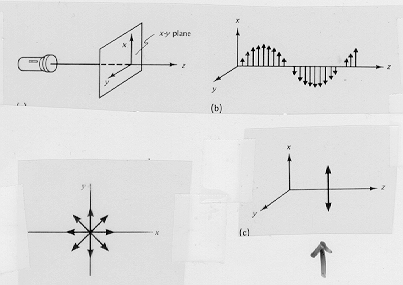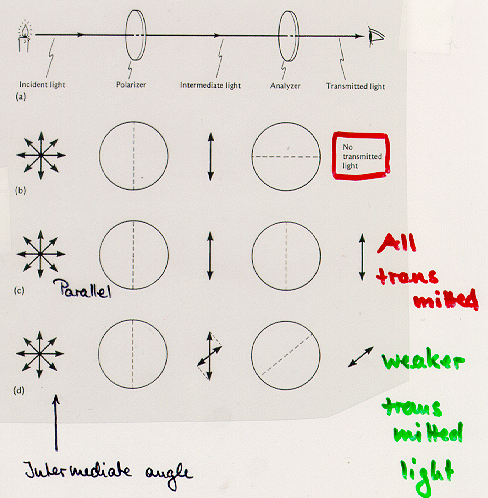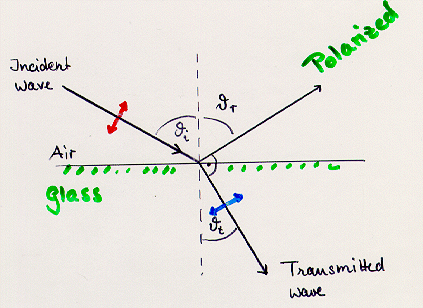
Color I



 Polarization
Polarization|
The polarization characterizes the direction in which the electric
field of the light wave oscillates. For example, if the field oscillates
up and down, then its polarization is vertical. The polarization
must always be perpendicular to the ray, because the ray gives the
direction of propagation, and the electric field must be perpendicular
to that direction. So another possibility would be horizontal
polarization, where the electric field oscillates from left to right and
vice versa. If the electric field direction changes so randomly that no directon of polarization is preferred over any other, we call the wave
 unpolarized unpolarized
Most natural light, such as sunlight, moonlight, lightbulb light (but not all star light) is unpolarized.

 linearly polarized linearly polarized
in the x-direction (part (b) and (c) of the figure). Similarly,
a wave whose electric field is always parallel to the y-axis
is linearly polarized in the y-direction.
 Polarizing and
Analyzing Polarizing and
Analyzing
A polarizing filter can be used in two different ways. It can be
used as polarizer, because it tansmits only one component
of the polarization. Incident unpolarized light striking a polarizing
filter results in polarized transmitted light. The following figure shows a set-up using two polarizing filters, one as polarizer and one as analyzer.

Ponder: What transmitted light results if the polarizer is oriented horizontally in the figure?
Clearly, there is not always a polarizer available to polarize light. However, there are other mechanisms due to which unpolarized light can become polarized.
 Polarization due
to Scattering Polarization due
to Scattering
Imagine that an unpolarized wave travelling in z-direction strikes a small scattering (basics of Rayleigh scattering). Since the electric field of hte unpolarized wave oints in all directions in the x-y plane, (but not in z-direction), the charges in the scatterer will oscillate in all those directions, but not in the z-direction. The oscillations in the x-y plane have a x- and a y-component. However, only the x-component of oscillation radiates in the y-direction, the y-component cannot (because the scattered wave is transverse), and there is not z-component (because the incident wave is transverse). Hence any light radiated in the y-direction is linearly polarized in x-direction. With a similar argument, light radiating in the x-direction is linearly polarized in y-direction.
For the blue, Rayleigh scattered light this means that he blue light
is linearly polarized for light coming from points in the sky
90 deg away from the sun. However, the light coming from diretions near
the sun or opoosite the sun is unpolarized. For regions inbetween it
is partially polarized, a mixture of polarized and unpolarized
light. Because of the polarization of the light from the blue sky, a poperly oriented polarizing filter in front of your camera can block out that that light, increasing hte contrast beween the sky and the white clouds as in this photograph of taken in the middle of the day in Mexico.
 Polarization due to
Reflection
Polarization due to
Reflection
A wave with its E-field perpendicular to the plane-of-incidence reflecting and refracting at an interface. Electrons then oscillate perpendicular to the plane-of-incidence and reradiate light perpendicular to that plane.

When light coming from air strikes a smooth glass surface at an angle of
incidence, The figure is drawn for a special case, where the transmitted and reflected rays happen to be at right angles to each other and the oscillations of the E-field occur in the plane-of-incidence. If this is the case, the reflected light will be polarized. How can this be explained? For the specific situation given in the figure and light polarized in the plane of the figuer, the electric field in the glass, and thus the direction in which the charges oscillate there, is perpendicular to the transmitted ray. It is the radiation from these oscillating charges, that produces the reflected ray. Because light is transverse, these charges cannot radiate along their direction of oscillation. Hence there cannot be a reflected ray perpendicular to the transmitted ray. Thus, the intensity of the reflected ray is zero for this special angle of incidence, called
 Brewster's angle
Brewster's angle
Thus, if an unpolarized beam arrives at the Brewster's angle of incidence, only one component of polarization is reflected. The reflected light is then linearly polarized. At nearby angles this is almost true, i.e. of light polarized in the plane of the figure, very little is reflected. Hence, the reflected light is partially polarized, consisting of a large component of one polarization and a small component of the other. Since one often looks at objects at angles near Brewster's angle, much of the reflected light one sees is polarized. Water surfaces or snow are especially good reflectors of light, so one can expect that the reflected light has a large polarized component. This can be seen in the two photographs shot in snow. For the right one a polarizing filter was used, for the left one not. The situation is different for metals. Since in metals electrons are moving quite freely parallel to the surface, they can radiate in all directions away from the surface and can hence create reflected beams of both polarizations, which means the light reflected from metal surfaces is not polarized.
 Optical Activity Optical Activity
When linearly polarized light passes through an optically active material, its direction of polarization is rotated. The angle through which the polarization is rotated depends on the thickness of the material and the wavelength of the light in that material. If you put some optically active material between a polarizer and an analyzer, then, depending on the orientation of the analyzer (compared to that of the polarizer), different colors will be removed from the transmitted light. |

Ch. Elster